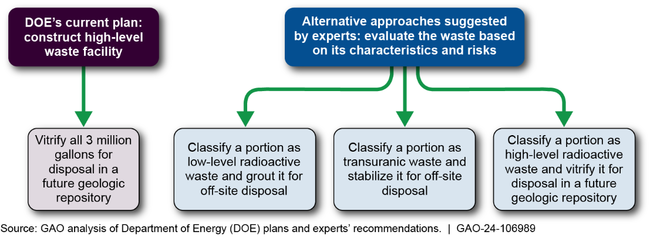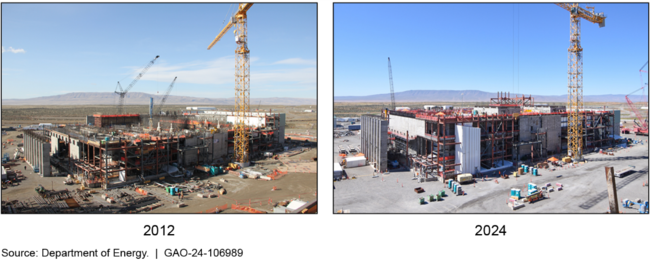Hanford Cleanup: Alternatives for Treating and Disposing of High-Level Waste Could Save Billions of Dollars and Reduce Certain Risks
Fast Facts
The Department of Energy has been building facilities to treat highly radioactive waste at its Hanford site in Washington state. One facility will cost $10 billion to finish and will treat 3 million gallons.
Experts said there are alternative methods for treating this waste. They say that these methods could help DOE remove waste from the state earlier, and save taxpayer money.
DOE hasn't fully analyzed the potential for these alternatives and is hesitant to deviate from its plan, despite having time to do so.
Our recommendations to DOE, and one for Congress to consider, address this and more.
Hanford’s High-Level Waste Facility Construction Project

Highlights
What GAO Found
The Department of Energy's (DOE) planned approach to treating about 3 million gallons of Hanford's waste with the highest radioactivity—Hanford's high-level waste (HLW)—is to ramp up construction of the HLW Facility, where the HLW would be vitrified (immobilized in glass). Construction of this facility was paused in 2012 due to technical challenges. In 2022, DOE resumed construction and has since spent over $200 million on the facility. However, DOE has not fully addressed the challenges that led to the pause. DOE also has not considered all viable alternatives for addressing the HLW. While DOE analyzed alternatives for HLW treatment in 2023, it only evaluated alternatives that included vitrifying the waste in the HLW Facility. This limited evaluation was inconsistent with DOE requirements for developing such analyses.
In addition, an April 2024 agreement among DOE, the U.S. Environmental Protection Agency (EPA), and the Washington State Department of Ecology proposed sweeping changes to DOE's approach for cleaning up the Hanford Site. The agreement proposes that DOE reconfigure HLW Facility for a direct-feed approach under which DOE would send HLW directly to the HLW Facility and vitrify it. This approach would not rely on the Pretreatment Facility—stalled since 2012 due to technical challenges—originally intended to prepare the waste for treatment. However, the agreement does not specify how DOE would prepare the HLW for treatment in the absence of the Pretreatment Facility or how it would reconfigure the HLW Facility for the direct-feed approach.
Alternative approaches for addressing Hanford's HLW were discussed by a group of experts during meetings convened by GAO and the National Academies of Sciences, Engineering, and Medicine (National Academies) in early 2024. According to experts, portions of Hanford's HLW could be classified as low-level radioactive waste (LLW) or transuranic (TRU) waste because of the physical characteristics and level of risk posed by the waste. Experts emphasized that waste classified as LLW or TRU waste has existing disposal options and would not require vitrification. In contrast, there is currently no repository for the disposal of high-level radioactive waste. Classifying some portions of the HLW as LLW or TRU waste could allow DOE to treat those portions using methods that are less expensive than vitrification and to dispose of them in existing facilities.
Approaches for Treating Approximately 3 Million Gallons of Highly Radioactive Waste at the Hanford Site

If DOE could manage portions of the HLW as LLW or TRU waste, it could use simpler treatment technologies, such as drying and packaging the waste or immobilizing it in concrete, according to experts. None of the alternative approaches that experts identified would require the Pretreatment Facility, which DOE estimated would cost an additional $9 billion to complete. Some of the HLW should still be managed as high-level radioactive waste and vitrified accordingly, experts said. However, they suggested that the HLW Facility as currently designed may not be needed and the vitrification capability could be right-sized for a smaller volume of waste. Experts said this could result in potential cost savings from processing less waste and avoiding construction of certain infrastructure, such as cross-site waste transfer lines. The experts also said that using approaches targeted at specific characteristics of the waste would allow DOE to begin waste treatment sooner, resulting in cost savings, reduced schedule, and decreased risks to human health and the environment.
However, DOE faces legal and regulatory uncertainties in implementing alternative approaches, according to experts. For example, experts stressed that DOE needs greater clarity about its legal authority to classify some of the HLW as a waste type other than high-level radioactive waste. DOE has existing processes for doing so, but each process has limitations that prevent DOE from applying it to Hanford's waste or that could leave the agency vulnerable to legal challenges. Congressional action to clarify DOE's authority to classify certain tank waste at Hanford as LLW or TRU waste could help DOE save billions of dollars and complete its waste treatment sooner.
Some of the alternative approaches that experts identified may be compatible with the April 2024 proposed agreement, which anticipates DOE will reconfigure the HLW Facility and does not specify a particular volume of waste that must be treated through the facility. These include alternatives that involve reducing the volume of waste to be treated as high-level radioactive waste and right-sizing the HLW Facility. As DOE prepares to reconfigure the HLW Facility, it has an opportunity to obtain an independent analysis to support an optimal HLW treatment path. By pausing engineering design and construction activities on the HLW Facility until it obtains this analysis, DOE will have greater assurance it has considered all viable alternatives for treating Hanford's HLW and chosen the optimal approach before devoting more taxpayer resources to the facility.
Construction of the High-Level Waste Vitrification Facility at Hanford

Why GAO Did This Study
DOE oversees the treatment and disposal of about 54 million gallons of radioactive and hazardous waste at the Hanford Site in Washington State. DOE has historically planned to manage a portion of this waste—Hanford's HLW—as a waste type (high-level radioactive waste) that requires treatment by vitrification and disposal in a deep geological repository. DOE currently plans to pretreat the HLW and vitrify it in facilities that have been under construction since 2000 and are estimated to cost about $20 billion to complete. DOE intends to store the vitrified waste on-site at Hanford until the establishment of a deep geologic repository.
Senate Report 118-58 includes a provision for GAO to assess DOE's plans for minimizing the portion of waste at Hanford that will be treated as high-level radioactive waste. This report examines (1) the status of DOE's current approach to addressing Hanford's HLW; (2) alternative approaches that could minimize the fraction of waste that would require treatment as high-level radioactive waste and the extent to which these approaches would affect DOE's current cost and schedule estimates; and (3) steps, if any, DOE could take to pursue alternative approaches.
GAO reviewed DOE reports; interviewed DOE, EPA, and Washington State officials; and worked with the National Academies to convene meetings of 17 experts to discuss options for addressing Hanford's HLW.
Recommendations
GAO is recommending that Congress clarify DOE's authority to manage portions of Hanford's tank waste as a waste type other than high-level radioactive waste. GAO is also making three recommendations to DOE, including that it pause work on the HLW Facility until it takes several actions, including considering other alternatives for addressing Hanford's HLW.
DOE agreed with two of GAO's recommendations and disagreed with GAO's third recommendation that it pause work on the HLW Facility. DOE stated that pausing activity on the HLW Facility would be in conflict with existing cleanup milestones and proposed changes to those milestones in the April 2024 agreement.
GAO disagrees because the current deadline for DOE to complete the HLW Facility is more than 9 years from the date of this report. Further, the April 2024 proposed agreement indicates that the parties intend to modify this deadline as additional information is developed. GAO's recommended pause in activity on the HLW Facility does not specify a length of time, and GAO emphasizes that such a pause should be undertaken in coordination and negotiation with DOE's regulators. GAO believes sufficient time exists for DOE to complete this coordination and factor in the recommended pause while remaining faithful to its regulatory commitments.
Matter for Congressional Consideration
| Matter | Status | Comments |
|---|---|---|
| Congress should consider clarifying—in a manner that does not impair the regulatory authorities of EPA and the State of Washington—DOE's authority at Hanford to determine, in consultation with the Nuclear Regulatory Commission, whether portions of the tank waste can be managed as a waste type other than high-level radioactive waste. (Matter for Consideration 1) | As of February 2025, Congress has not passed legislation that would implement this matter. |
Recommendations for Executive Action
| Agency Affected | Recommendation | Status |
|---|---|---|
| Department of Energy | The Secretary of Energy should ensure that the Senior Advisor for Environmental Management targets research and development projects for addressing Hanford's HLW toward known approaches that have the potential to reduce risks, schedule, and costs, such as the approaches identified by experts in this report and those in the 2022 Research and Development Roadmap for Hanford Tank Waste Mission Acceleration. (Recommendation 1) |
In January 2025, DOE said they had initiated technology development efforts for management and treatment of HLW. According to DOE, these efforts included awarding research and development contracts related to the 2022 Research and Development Roadmap for Hanford Tank Waste Mission Acceleration. We will continue to evaluate implementation of this recommendation.
|
| Department of Energy | The Secretary of Energy should ensure that the Senior Advisor for Environmental Management has an independent analysis performed, such as by a Federally Funded Research and Development Center, on opportunities to optimize, in a manner that is protective of human health and the environment, the portion of Hanford's high-level waste that should be managed, treated, and disposed of as high-level radioactive waste based on the physical characteristics of the waste. (Recommendation 2) |
In January 2025, DOE said they plan to have an independent HLW treatment optimization analysis performed, such as by a Federally Funded Research and Development Center, of alternatives to manage, treat, and dispose of Hanford's HLW within the context of legally and regulatorily permissible options. We will continue to evaluate implementation of this recommendation.
|
| Department of Energy |
Priority Rec.
The Secretary of Energy should ensure the Senior Advisor for Environmental Management pauses engineering design, reconfiguration, and construction activities on the HLW Facility at Hanford until DOE (1) defines a mission need for the HLW project that is independent of a particular facility, technological solution, or physical end-item; (2) considers the results of an independent analysis of opportunities to optimize the portion of Hanford's HLW that should be managed, treated, and disposed as high-level radioactive waste; and (3) addresses technical issues with the HLW Facility identified by DNFSB. (Recommendation 3) |
DOE did not concur with our recommendation and, as of January 2025, has taken no action to implement it. In its comments to our report, DOE stated that pausing activity on the HLW Facility would conflict with existing cleanup milestones and DOE's plan to complete the HLW Facility by 2033. DOE also said it will continue to seek opportunities to optimize the amount of the waste to be treated in the facility while also working with the Defense Nuclear Facilities Safety Board to resolve technical issues. We disagree that pausing activity on the HLW facility would conflict with cleanup milestones. The current deadline for DOE to complete the HLW Facility is more than 8 years away and the recent holistic agreement with the State of Washington allows for further negotiations about the HLW treatment mission and timelines. We believe sufficient time exists for DOE to determine an optimal solution for treating the HLW while remaining faithful to its regulatory commitments.
|
